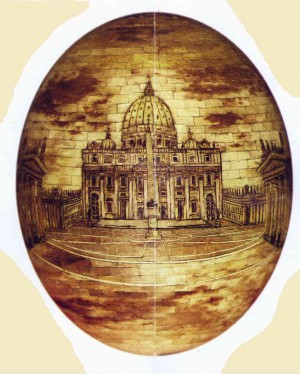Among several gifts that will be given Pope Francis when he comes to the Philippines next week is an ostrich egg that belies its seeming insignificance upon closer look.
Philippine Ambassador to the Vatican Mercedes Tuason would present the work to the Pope, said artist Fernando “Pando” Manipon.
Like an artist’s canvas, the ostrich egg has become a medium of representation to depict in convex dimensions Saint Peter’s Basilica, where Pope Francis as successor of Christ’s chief apostle holds office.

Simon Peter was called “The Rock” by Jesus Christ, who said in the Sacred Scriptures that “the gates of hell won’t prevail” against his Church. Big but frail, the ostrich egg obviously cannot adequately symbolize the power and authority of the Church.
But looking closer again at the image on the ostrich egg, one finds that it is not a painting but a “mosaic.”
In fact, it is a mosaic of bits of dried and brown leaves (hence the sepia color), which had been collected from the trees by Manipon that were felled as a result of the strong typhoon that has ravaged the Philippines lately, notably Supertyphoon “Yolanda” (internationnal name “Haiyan”) in 2013.
Thus, rather than show the power and authority of the Church, the ostrich-egg art attempts to show her mercy and compassion to people who have been visited by poverty and natural calamities.
In fact, Pope Francis’ papal insignia and motto—Miserando atque eligendo, “lowly but chosen,” or literally, “by having mercy He chose him” (from the Gospel of Matthew)—are delicately inscribed on top of the egg.
Mercy and compassion are the underlying theme of the Pope’s pastoral visit of Asia.
Before he Philippines, the Pope will be in Sri Lanka to show his solicitude to the survivors and the families of victims of the December 2004 tsunami as well as the families of casualties from the just-ended Tamil insurgency.
In the Philippines, the Pope will visit Leyte, one of the hardest-hit provinces in Eastern Visayas by “Yolanda,” in order to console survivors and the families of those who perished or went missing.
‘Collage’
But Manipon hit upon his art of the storm-tossed dry leaf much earlier than the 2013 supertyphoon.
In 2009, after the drenching devastation of Tropical Storm “Ondoy,” he saw his balcony a mess with leaves from toppled or badly shaken trees.
Taking his inspiration from Japanese artist Katsuo Akasaki who specialized in leaf paintings, Manipon gathered the leaves and created a “collage” of Malate Church.
The hobby later became an obsession. Masterfully breaking down the leaves into fragments like marble shards used in mosaic art, Manipon made detailed works of key churches of Europe as well as the four Unesco World Heritage-listed Baroque churches of the Philippines.
Manipon has exhibited his works at the San Agustin Museum and the art gallery of the National Commission for Culture and the Arts.
Among his leaf paintings are La Sagrada Familia in Barcelona, Spain; the Cologne Cathedral; and the famous rose window of Notre Dame in Paris. In memory of the Bohol churches that were destroyed during the great earthquake of 2013, Manipon has also done leaf paintings of the churches of Maribojoc, Loon and Loboc.
Impy Pilapil has seen the leaf paintings and praised them:
“To say that Pando’s latest works are inspiring is an understatement—‘iconic’ would be a more appropriate word and in a way, almost a literal one. Made from fallen, dried, yet delicate leaves of various shapes and forms, his current oeuvre are amazing depictions of churches, saints, and religiously relevant locations and scenes, all meticulously crafted from the chaotic aftermath of a tropical storm that left his balcony in utter disarray. Little did he know that these battered-down leaves would serve as both muse and media for what is to become his defining cultural contribution.”
Writer Maria Lourde de Vera said Manipon’s St. Peter’s Basilica “compresses this Renaissance masterpiece on an ostrich egg” and is “a tour de force, reminiscent of mosaics on 8th-century urns.”
“Greco-Roman artisans used black and colored marble cut into tiles, more or less 2 millimeters in size, to achieve very fine details and the illusion of a painting,” De Vera explained.
In contrast, she said, Manipon’s “ova is a micro-mosaic of dried leaves, calculated in shape and size. Rectangular and trapezoidal dried leaves, 1 centimeter at the egg’s girth, gradate to 2 millimeters as they round its top and bottom, forming a unified construction of the ovoid dome and the elliptical piazza.”
“From the egg’s virtual plane,” the writer added, “the Egyptian obelisk obstructs the view of the loggia from where the Pope gives his apostolic blessing, urbi et orbi, and the central statue of the Redeemer atop the basilica’s balustrade.”
Manipon said the egg is presented inside a vitrina, set upon a revolving mechanism to allow a dorsal view of the basilica.
Pilapil said Manipon’s works bear a “distinct aesthetic style.” “Where he has taken this style is nothing short of extraordinary,” she wrote. “It is unique for this time and is a testament to the ingenuity and the tenacity of a true creative spirit.”
RELATED STORIES
Pope Francis to say Masses in English in PH visit
3 papal visit days declared special non-working days













































